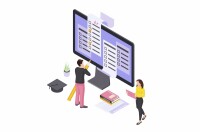Search
There are 11 results.
Category
Tag
Tag
All (47)
Active Learning (3)
Assessments (1)
Asynchrony (2)
Authentic Activities (3)
Backwards Design (2)
Canvas (1)
Case Studies (1)
Collaboration (1)
Communication (2)
Community (3)
Competency-Based Education (3)
Content Creation (7)
Copyright (2)
Course Maintenance (1)
Course Materials (5)
Course Preparation (4)
Discussions (1)
Diversity (1)
Equity (1)
Feedback (5)
Formative Assessments (7)
Game-Based Learning (2)
Gamification (1)
Generative AI (1)
Group Work (2)
Inclusion (2)
Infographics (1)
Learning Objectives (3)
Multimodality (3)
Presentations (1)
Representation (1)
Rubrics (1)
Scaffolding (1)
Synchrony (2)
Third-Party Tools (1)
Universal Design for Learning (UDL) (3)
Video (4)
Visual Design (1)
Written Assignments (1)
Incorporating Multimedia in Your Course
Multimedia, which helps create an engaging and interactive online learning environment, has been shown to contribute to improved student performance (Cheng et al., 2009, p. 1). Though many online courses incorporate videos, they neglect to feature other forms of multimedia. And, while videos are a staple of multimedia use, there are other exciting options to consider: podcast episodes, graphics, and animations can all enhance course content, enriching the student experience. To maximize the benefits multimedia can provide, consider including these underutilized forms of multimedia in your course.
Copyright
From time to time instructors may want to include in their courses copyrighted materials like images, print content, audio recordings, or videos. The University of Minnesota Libraries define copyright as “the area of law that deals with creation, ownership, sale, and use of creative and expressive works” (2011, What can have a copyright? section).
Building Your Online Course With the Lister Model
You are building a course for the online environment. What an exciting adventure! When building an online course, you might use a similar method to what you used when developing a course previously, or you might use an entirely new technique. Either option is a good option. But you may have a few questions when you first begin: How do I organize my materials? How do I display my materials? How do I make sure my students work together?
Quizzes for the Multimodal Course
From trivia games to final exams, quizzing tools have a variety of uses for learning as well as assessment. Exams and quizzes have a particularly plentiful range of possibilities in a multimodal or hybrid course, where they can be administered synchronously or asynchronously. Research suggests that the presentation of a tool influences student behavior in response to the tool. When comparing two student discussion boards, one an ungraded discussion and one a graded replacement for a final exam, Cheng et al. (2013) found that students displayed more knowledge on the graded board but more evidence of learning on the ungraded board. The students who participated in the study were more likely to grapple with new ideas when the stakes were low but more eager to showcase topics they were confident about when their responses would have a greater impact on their grades. When considering quizzing tools, we recommend allowing your course goals to guide your usage.
Data-Centric Recommendations for Video Engagement
Incorporating prerecorded videos and animations into online learning experiences allows students the opportunity to access content at any time after the material is delivered. The inclusion of video and animation in online learning is now ubiquitous. To promote engagement, it is imperative that such content be delivered to learners clearly and effectively.
Best Practices to Support Student Well-Being
Mental health concerns are prevalent among undergraduate and graduate students and can have deleterious consequences (Chi et al., 2023; Venable & Pietrucha, 2022). In particular, students struggling with their mental health are less likely to pass their courses and more likely to drop out of their programs of study (Lister & McFarlane, 2021). While universities often provide support systems in the form of accessibility services and counseling centers, several significant issues can lead to the underutilization of available resources among students in general and online students in particular. First, students may need to be physically present on campus in order to access support systems (Lister et al., 2023). As a result, students enrolled in online programs may be unable to use them. Additionally, students may not capitalize on available resources due to logistical challenges (e.g., scheduling), feelings of discomfort in asking for help, or concerns about stigmatization (Venable & Pietrucha, 2022).
Best Practices to Support Students With Cognitive Disabilities
Cognitive disabilities are common among adults in the United States and are especially prevalent among young adults (Okoro et al., 2018). Such disabilities impact mental functions such as memory, attention, perception, and calculation, among others. As a result, students with cognitive disabilities may struggle with academic tasks generally—and online coursework specifically—in unique ways (Petretto et al., 2021; Reyes et al., 2022). Since online courses are often text-heavy, for example, students with dyslexia may find them more challenging to navigate than on-ground classes (Chen et al., 2015). Students with cognitive disabilities may also struggle with navigating inconsistent online course layouts, comprehending complicated directives, and engaging with non-essential course components. Finally, when online courses are large or impersonal, students with cognitive disabilities may have difficulty focusing on assignments and other coursework (The Best Schools, 2024).
Developing Instructional Materials
Once you have defined the learning objectives for your course, you can begin to develop assessments to ensure students achieve those objectives. Once you have created assessments, you can begin to develop materials to ensure students succeed on those assessments. This backward design process—which moves from objectives to assessments and finally to materials—is known as learning-centered instruction, and it directs every course task toward the development of certain skills and competencies. This piece focuses on the third stage of this process, the development of high-quality instructional materials, beginning with the idea that robust and engaging online courses contain a mix of created and curated content. Below, you will find guidelines for creating and curating instructional materials to help you achieve the optimal balance for your course.










